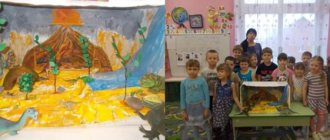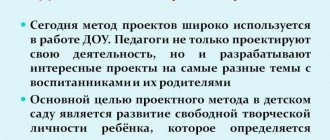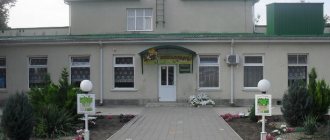Project activities in preschool educational institutions. Nekhorosheva Natalya Stanislavovna
author: Nekhorosheva Natalya Stanislavovna
teacher, Tomsk city MADOOU No. 13
Project activities in preschool educational institutions
The project method as a means of developing the cognitive activity of preschool children.
Nekhorosheva Natalya Stanislavovna, teacher of the first
qualification category MADOU No. 13, Tomsk
The introduction of the Federal State Educational Standard for Preschool Education as a new paradigm of education, including preschool, involves replacing traditional methods of teaching and upbringing with innovative technologies aimed at improving the development of a child’s personal competencies by integrating various types of activities and uniting in them all participants in the educational process: teachers, children , parents. It is integrativeness, compliance with the technology of developmental education, and ensuring the activity of children in the educational process that explains the interest of preschool teachers in project activities as a way of organizing the educational process.
The project method is a pedagogical technology, the core of which is the independent research, cognitive, playful, creative, productive activities of children, in the process of which the child gets to know himself and the world around him, and translates his knowledge into real products.
A project is a joint educational, cognitive, creative or gaming activity of partner students, which has a common goal, agreed upon methods, methods of activity, aimed at achieving a common result in solving a problem that is significant to the project participants. It is the main form of organizing students’ cognitive activity within the framework of the project method.
The project method as a pedagogical technology arose in the USA in the second half of the 19th century. Its theoretical basis was the “pragmatic pedagogy” of the American idealist philosopher John Dewey.
The main conceptual provisions of his theory were as follows:
- Only that which gives practical results is true and valuable;
- the child in his development repeats the path of humanity in understanding the world around him (from the particular to the general, by the inductive method);
- the assimilation of knowledge is a spontaneous, uncontrolled process;
- a child can assimilate information only due to the emerging need for knowledge, being an active subject of his own learning.
The conditions for successful learning according to D. Dewey’s theory are:
- problematization of educational material;
- cognitive activity of the child;
- connection of learning with the child’s life experience;
- organization of learning as an activity (play, work).
Thus, D. Dewey essentially proposed replacing abstract education, divorced from life, aimed at memorizing theoretical knowledge, with a system of schooling “by doing,” which enriches the child’s personal experience and consists in his mastering a way of independently understanding the world around him.
One of the ways to further implement Dewey's ideas was training using the “project method”.
The project method (from the Greek - the way of research) is a teaching system in which students acquire knowledge in the process of planning and performing gradually more complex practical tasks - projects.
Russian teachers developed the fundamentals of project-based learning almost in parallel with American ones. A small group of teacher researchers under the leadership of S. T. Shatsky has been working on the problem of introducing the project method into teaching practice since 1905 of the 20th century.
The student’s personal interest was a necessary condition for successful work. The problem should be taken from real life, and it should be familiar and meaningful to the child. To solve it, both previously acquired knowledge and those that had yet to be acquired were required. The teacher-consultant supervised the project work, directing the students’ search and suggesting sources of information. The project method was reflected in the ideas of domestic teachers of the 20-30s of the XX century: B.V. Ignatieva, V.N. Shulgina, N.K. Krupskaya, E.G. Kagarova, M.V. Krupenina.
M. V. Krupenina rightly believed that the project method comprehensively implements such pedagogical principles as amateur performance, cooperation between children and adults, taking into account age characteristics, an activity approach, updating the child’s subjective position in the pedagogical process, and the relationship of the pedagogical process with the environment.
Russian teachers believed that this helps develop children's creative initiative. Some active supporters of the project method (V.N. Shulgin, M.V. Krupenina, B.V. Ignatiev, etc.) proclaimed it to be the only correct method of teaching at school. They believed that the school of study thus turns into a school of life. In 1920, the Project Method and its variant “Dalton Plan” began to be used in Russian schools. However, as a result of the universalization of the project method, the level of general education training of students in Russia sharply decreased, which was condemned in the decree of the Central Committee of the All-Union Communist Party of Bolsheviks “On Primary and Secondary Schools” (1931), and the subject teaching system and class-lesson teaching system were proclaimed as the only true ones.
Modern researchers of the history of pedagogy note that the use of the project method in modern school in the 1920s. indeed led to an unacceptable decline in the quality of education. Among the reasons for this phenomenon are:
– lack of trained teaching staff capable of working with projects;
– poor development of design work methodology;
– hypertrophy of the project method to the detriment of other teaching methods;
– a combination of the project method with the pedagogically illiterate idea of “complex programs”.
At the same time, he developed actively and very successfully in a foreign school. In the USA, Great Britain, Belgium, Israel, Finland, Germany, Italy, Brazil, the Netherlands and many other countries, the ideas of J. Dewey’s humanistic approach to education and his project method have found wide circulation and gained great popularity. In foreign schools, the project method is developing actively and quite successfully to this day. The Coalition of Essetial Schools, or CES for short, is a network of schools belonging to the alternative direction of the US education system. Productive education (CES) poses a specific task: to create conditions for psychological and pedagogical support for student initiative.
Currently, in connection with the modernization of Russian education, the problem of reviving the project method in domestic pedagogical practice has arisen, and special attention is paid to the introduction of the project method in preschool education. Its use is connected, as before, with the idea of educating a person, as defined by E. S. Polat, “who knows how to work, constantly showing his initiative, who sets broad practical tasks for himself and knows how to fulfill them.”
Issues of using the project method in modern conditions as a means of activating independent educational and cognitive activity of schoolchildren are reflected in the works of M. Yu. Bukharkina, V. Guzeev, M. V. Moiseeva, A. P. Oreshko, N. Yu. Pakhomova, E. S. Polat, I. D. Chechel and others.
In preschool education, the project method actually took its “first steps.” Mostly methodological works have appeared that reveal certain aspects of using the project method in the educational process of preschool educational institutions (T. I. Babaeva, I. V. Garifullina, L. S. Kiseleva, T. A. Danilina, T. S. Lagoda, M. B. Zuykov) where this method is understood as a variant of an integrated method of teaching preschoolers, as a way of organizing the pedagogical process, based on the interaction of teacher and student, step-by-step practical activities to achieve the goal.
The authors of the manual “Project Activities of Preschool Children” N.E. Veraksa, A.N. Veraksa, outlined the wording: “Project activity involves different forms of children’s activity depending on the plan”; during the implementation of the project, the preschooler explores various options for solving the task, according to certain criteria, selects the optimal solution path.
This determines the basic requirements for using the project method in kindergarten:
- At the heart of any project is a problem that requires research to solve;
- mandatory components of the project: children's independence (with the support of the teacher), co-creation of children and adults;
- development of children's communication abilities, cognitive and creative skills.
Taking into account the psychological and age characteristics of preschool children, we can distinguish three levels of project activity of preschoolers:
- Imitative-performing (3.5-5 years).
At this level, the child does not yet have rich life experience, and his creative abilities are not sufficiently developed. Therefore, he cannot be fully independent in choosing and solving a problem. The teacher has an active role. The child, through his needs and interests, acts as the customer of the project. The child’s implementation of the project occurs at the imitative-executive level. He participates in planning activities and carries out project tasks.
- Developmental (5-6 years old).
At this age, children have already accumulated a certain social experience, they are developing independence and arbitrariness; self-esteem and self-control. Five-year-old children are already able to accept the problem and clarify the goal. They can choose the means necessary to achieve the result. At this level, the teacher’s assistance is insignificant.
- Creative (6-7 years old).
At this age, all aspects of a child’s personality are formed: moral, emotional-volitional, intellectual, effective-practical. Children independently determine the goal, plan the content of the activity, and choose ways to work on the project. The teacher must support and develop children's creative activity, create conditions that will allow children to independently determine goals and organize work on the project.
Psychological and pedagogical research shows that at the stage of preschool childhood, the development of various forms of knowledge of the surrounding world and perception, imaginative thinking, and imagination is of particular importance.
It is believed that design and research activities are most applicable in schools, however, in preschool institutions there are all the prerequisites for using this teaching method. However, when organizing this work with preschool children, it is necessary to take into account the age-related psychological and physiological characteristics of children.
Children of preschool age can carry out design and research activities just as effectively as schoolchildren, since their psychological characteristics provide all the prerequisites for this:
- the desire for research, knowledge based on sensations;
- desire for independent activity, regardless of adults;
- interest in information that can be applied practically;
- desire for a variety of activities.
However, a number of features of the psychological and psychophysical development of children of this age create the need for some adjustment of the process of design and research activities, in accordance with these features, namely:
- small amount of accumulated knowledge and experience;
- constant need to interact with adults;
- inability to concentrate on one activity for a long time;
- limited ability to independently work with sources of information.
In modern pedagogical practice, there are many variations in the understanding of this form of organization of the educational process as a project. However, a certain classification of projects that can be implemented in preschool institutions has been adopted (Table 4.
Table 4
Classification of projects in preschool educational institutions
| By number of participants | By topic | By subject area | By duration | ||
| Individual | Creative | Mono projects | Short term | ||
| Doubles | Practice-oriented | Interdisciplinary | Medium term | ||
| Group | Information-oriented | Long-term | |||
| Collective | Role-playing games | ||||
| Research | |||||
The project method can be used in working with children, not only older ones, but also starting from early preschool age. The objectives of research activities for each age are specific, they allow us to determine the objectives of learning, to form the prerequisites for educational and research skills in accordance with the main lines of development. Therefore, design and research activities in a preschool institution should be carried out at a level accessible to children, and the research itself should be feasible, interesting and accessible. The smaller the child, the simpler the project. Young children are able to schedule their work for a day or several hours. Projects in preschool age are uncomplicated and simple.
Traditional pedagogical activity is carried out in a normative space - it is focused on developed lesson notes, a strict logic of transition from one part of the program to another. Project activity, on the contrary, is carried out in a space of possibilities where there are no clearly defined norms. In this case, both the teacher and the children find themselves in a situation of uncertainty. Project activity is focused on exploring as many possibilities as possible in a situation, rather than following a predetermined (and known to the teacher) path. Naturally, it is easier for a teacher to follow a rigid program than to constantly look for new non-standard approaches to the educational process. Therefore, each teacher must assess his readiness for project activities.
The pedagogical value of projects is determined by:
- the possibility of its implementation by the child or the group;
- the content of new problems;
- skills and abilities that the child develops while working on the project;
- the child's interest in working on the project.
ON THE. Ryzhova identifies three main stages of project implementation for preschoolers:
- Preparatory: goals and objectives are set, research methods are determined, preliminary work is carried out with children and their parents, with teachers, equipment and materials are selected;
- Research: searching for answers to questions posed in different ways;
- Summarizing: analysis and synthesis of work results in various forms, formulation of conclusions and drawing up recommendations.
In the educational process of a preschool educational institution, project activities are in the nature of cooperation, in which children and teachers of the preschool educational institution take part, and parents and other family members are also involved.
The preschooler must clearly imagine not only the task facing him, but also the ways to solve it, and with the help of the teacher, draw up a plan for working on the project.
Table 5
Activities of the teacher and children by stages of the project
(according to T.A. Danilina)
| Project stages | Activities of a teacher | Children's activities |
| Stage 1 | 1. Formulates the problem (goal). (When setting a goal, the product of the project is also determined); 2. Introduces the game (story) situation; 3. Formulates tasks (non-rigidly); | 1. Entering the problem; 2. Getting used to the game situation; 3. Acceptance of the task; 4. Addition of project tasks; |
| Stage 2 | 4. Helps in solving a problem; 5. Helps plan activities; 6. Organizes activities; | 5. Uniting children into working groups; 6. Distribution of roles; |
| Stage 3 | 7. Practical assistance (if necessary); 8. Directs and controls the implementation of the project; | 7. Formation of specific knowledge, skills and abilities; |
| Stage 4 | 9. Preparation for the presentation; 10. Presentation | 8. The product of the activity is prepared for presentation; 9. Present (to spectators or experts) the product of the activity |
Work on the project can be carried out in full only if parents are involved in it. Experience shows that most of them provide assistance to teachers by exploring the chosen problem together with the children, which makes the work on the project more fruitful and of high quality. Areas of work with parents:
- Educational (presentation of information to improve the psychological, pedagogical, legal culture of parents); The teacher needs to introduce parents to this pedagogical technology, its role in the development of children, and motivate them to participate in organizing project activities.
- Practical and effective (increasing parents’ interest in carrying out a common task, demonstrating creative abilities, full-fledged emotional communication); joint collection of materials, production of attributes, games, competitions, presentations reveal the creative abilities of children, involve parents in the educational process, which naturally affects the results. Parents, participating in the implementation of the project, are not only sources of information, real help and support for the child and teacher in the process of working on the project, but also become direct participants in the educational process, enrich their teaching experience, experience a sense of ownership and satisfaction from their successes and the achievements of the child .
To include parents in project activities, it is necessary to inform parents about the projects being implemented in the group. Information in which parents are involved in collecting information can be displayed in the parent corner. Thus, parents will be informed about what topic interests their children and how much material they have. The prospect of working on the project opens up before them. In the future, during individual conversations, the teacher finds out from the parents more specifically who can provide what help from the proposed list.
At the same time, it is necessary to encourage parents to take initiative and gladly accept any help from them.
Practice shows that when applying the project method the following are observed:
- high activity of pupils;
- intensive independent cognitive activity of preschool children;
- increasing the personal value of completed projects;
- increasing the depth and volume of acquired knowledge and acquired skills.
Knowledge, skills, and abilities acquired consciously in the course of working on a personally significant problem are quickly acquired and consolidated by the child, transformed into his active stock of knowledge and practical experience, and easily transferred to other types of activities.
Thus, the essence of the project method is that the child, in the process of activity, masters a special skill - independently acquiring new knowledge in the process of solving life problems.
The experience of preschool educational institutions confirms that the use of the project method in the educational process helps to increase the interest of preschoolers in educational activities. This method develops the individual and collective activities of children and enables the teacher to implement a person-oriented approach to each child.
Cognitive activity, as one of the types of personal activity, does not have a uniform definition in scientific circles. Each researcher interprets it in his own way. But the analysis of scientific sources made it possible to identify two points in understanding the essence of cognitive activity:
- this is an integrative quality of personality, expressing the desire for knowledge;
is an activity.
As signs of a person’s cognitive activity, scientists identify: attitude to the content and nature of educational and cognitive activity; desire for self-knowledge, self-development; desire to learn; sustainable interest in the search for new knowledge, readiness for search activities; creative implementation of acquired knowledge and skills.
Cognitive activity includes a number of structural components that are interconnected, and each component takes its own position. As factors influencing the formation of a child’s cognitive activity, the authors who studied this problem identify: communication, the need for new experiences, and the general level of development of activity.
The levels of cognitive activity in modern psychological and pedagogical literature are determined by:
a) by the nature of cognitive activity: reproductive-imitative, search-executive, creative;
b) based on the state of readiness of cognitive activity: reproductive, applicative, interpretive, productive.
Also, different authors indicate different criteria and indicators of cognitive activity, but the most general ones can be identified: concentration, concentration on the subject being studied, initiative, positive emotional experiences and manifestations.
Cognitive activity is inherent in every person from birth, and is an intermediate step between cognitive interest and cognitive activity. At each age stage, the cognitive activity of preschoolers has its own characteristics: motives, means of cognition, intensity and stability of cognitive activity differ.
The essence of the project method is to stimulate children's interest in certain problems, the solution of which requires knowledge, and through project activities to demonstrate the application of this knowledge in practice. This allows us to consider this method as an innovation in preschool education. The project method can be used in working with not only older children, but also starting from early preschool age. It should only be taken into account that design and research activities in a preschool institution should be carried out at a level accessible to children’s perception, and the research itself should be feasible, interesting and accessible. Here the main role is played by the teacher - his task, without imposing his position on the children, is to “lead” the children to discover the problem, arouse their interest and desire for productive activity, and include other participants in the project, including parents and specialists.
Practice shows that with the correct organization of projects, the activity and independent cognitive activity of students increases, and there is also an increase in the depth and volume of acquired knowledge and acquired skills.
Bibliography.
- Azhibekov, K. Zh. Features of the formation of cognitive activity in preschool children [Electronic resource] / K. Zh. Azhibekov, G. O. Zhetpisbaeva [etc.] // International Journal of Applied and Fundamental Research. – 2021. – No. 3–1. – pp. 136–138. URL: https://applied–research.ru/ru/article/view?id=8688 (access date: 06/11/2019).
- Aksenova, T. A. Development of a preschooler in cognitive and research activities in the context of the implementation of the Federal State Educational Standard for Education / T. A. Aksenova // Young scientist. – 2021. – No. 12. – P. 1–6.
- Badanina, L.P. Diagnosis and development of cognitive processes: Workshop on general psychology / L.P. Badanina. – Moscow: Education, 2012. – 264 p.
- Berdibekov, P.K. Project activity in preschool education / P.K. Berdibekov, D.Kh. Fazilova, Ch. Yunusova // Young scientist. - 2021. - No. 1. — P. 691-693. — URL https://moluch.ru/archive/105/24943/ (date of access: 05/28/2019).
- Bliznetsova, V. S. Management of project activities of preschool teachers / V. S. Bliznetsova // Directory of senior educators: a methodological journal for kindergarten teachers. – 2009. – No. 9. – P. 21– 30.
Project activities in preschool educational institutions. Nekhorosheva Natalya Stanislavovna
Stages of organizing a project-based teaching method
The organization of the project-based teaching method provides for the sequence of the following stages:
- Determination of the research problem of the project, on its basis the formulation and setting of research objectives.
- Proposing a research hypothesis aimed at solving the assigned problems.
- Determination of research methods.
- Collection of data and primary information necessary for the research.
- Analysis of received data and information.
- Formulation and presentation of the final results of the study.
- Summing up: conclusions, adjustments (carried out through the use of the following methods: brainstorming, round table, creative reports, etc.).
Possible problems in organizing project-based teaching methods most often arise if the teacher does not have the necessary knowledge and experience:
- Can't keep statistics
- Does not know data processing methods
- Does not know various methods of creative activity
- Inability to logically and consistently organize the educational process as a whole
The choice of topics for project-based teaching methods in different situations is carried out differently:
- They are determined and approved by specialists from educational authorities within the framework of the approved educational program of the educational institution.
- Nominated directly by the teacher, based on the educational situation within the framework of the educational discipline that he teaches, as well as taking into account the interests, needs and abilities of the students.
- The proposal for project topics comes from the students themselves, who are guided not only by cognitive, creative and applied interests, but also by their own.
The topics of project-based teaching methods can relate to various fields of science, theoretical and practical issues of the curriculum. The main goal of the topic of the project-based teaching method is to deepen and expand the knowledge of individual students, as well as differentiate the educational process. Most often, the topic of the project is determined on the basis of a practical issue, which is relevant within the framework of practical life and requires the involvement of students’ knowledge not in one specific subject, but simultaneously from different areas. Thus, in the process of implementing the project, a natural integration of students’ knowledge is achieved.








